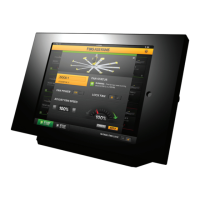
Do you have a question about the BIG ASS FANS BAFWorks 3.0 and is the answer not in the manual?
| Brand | BIG ASS FANS |
|---|---|
| Model | BAFWorks 3.0 |
| Category | Control Panel |
| Language | English |
Overview of the BAFWorks system, its purpose, and key components.
Addresses and phone numbers for Big Ass Solutions' manufacturing, customer service, and warranty departments.
Essential safety warnings and precautions for installing and operating BAFWorks equipment.
Introduction to Big Ass Fans and the company's commitment to quality and innovation.
Visual representation of how BAFWorks components connect in a typical installation.
List and images of the hardware required for wall-mounting the BAFWorks control system.
Details on fan control components, temperature sensors, and automation panels.
Steps for identifying network requirements and necessary hardware before installation.
Procedures for obtaining MAC IDs and configuring signal input types for ADAM modules.
A sequential guide outlining the entire installation process for the BAFWorks system.
Wiring diagrams for connecting power and data to ADAM modules for system integration.
Wiring examples for direct load control and using pilot relays with ADAM 6160 modules.
Wiring configurations for motor starters and start/stop circuits using relays.
Wiring for using relays as circuit enablers and for mechanically held lighting contactors.
Wiring for complex lighting circuits involving multiple switches and relays.
Detailed wiring diagram for a 6-channel lighting panel with contactors.
Wiring diagram for connecting loads to the 12x12x4 output panel using ADAM 6160 modules.
Wiring diagram for an 8-channel analog input panel with an ADAM 6117 module.
Specifications for indoor (EWS-TX) and outdoor (EWSE-PT100-TX) temperature sensors.
Best practices and locations for mounting indoor and outdoor temperature sensors.
Wiring examples for 4-20mA and 0-5VDC sensors to the ADAM 6117 module.
Dimensions for the mounting bracket and iPad enclosure for system mounting.
Instructions for installing the mounting bracket and attaching the iPad enclosure backplate.
Steps for connecting the BAF gateway, Wi-Fi router, and power supply to the mounting bracket.
Finalizing electrical connections and attaching the iPad enclosure and knockouts.
Introduction to fan installation using Modbus RTU protocol via BAFWorks application.
Overview of Modbus daisy chaining, address assignment, cable types, and EOL resistors.
Diagrams showing in-line and end-of-loop termination for the Modbus gateway.
Required parameter adjustments and final Modbus connections for Delta E VFDs.
Detailed wiring diagram for connecting Modbus cables to Delta E series VFDs.
Required parameter adjustments and final Modbus connections for Delta M VFDs.
Detailed wiring diagram for connecting Modbus cables to Delta M series VFDs.
Procedures for changing Lenze SMVector VFD parameters and making Modbus connections.
Diagram for connecting Modbus cables to Lenze SMVector VFDs.
Explanation and diagram for installing biasing resistors for reliable RS-485 data transmission.
Required parameter adjustments and Modbus connections for Allen-Bradley VFDs.
Diagram for connecting Modbus cables to Allen-Bradley PowerFlex VFDs.
Method for extending system capacity by daisy-chaining fans using 0-10VDC signals.
Discusses dry relay contacts and gateway-based methods for fire alarm system integration.
Guide to mounting, understanding dimensions, and operating the remote operator station.
Required parameter and jumper wire changes for Delta E VFDs when using a remote station.
Required parameter and jumper wire changes for Delta M VFDs when using a remote station.
Required parameter and jumper wire changes for Lenze SMVector VFDs with remote stations.
Required parameter changes for Allen-Bradley VFDs when connecting a remote operator station.
Steps before configuring ADAM modules, including utility download.
Configuring IP addresses, subnet masks, and default gateways for ADAM modules.
Configuring input ranges for sensors and recording module information.
Steps to add and configure ADAM 6160 output and ADAM 6117 input modules.
Setting up automation modes (Manual, Summer, Winter, Auto) and selecting temperature sensors for fan groups.
Setting up ventilation automation based on indoor and outdoor temperature thresholds and sensors.
Procedures for adding new fans to groups and removing existing fans.
Steps for creating new fan groups and deleting empty fan groups.
Procedures for adding new lights to groups and removing existing lights.
Steps for creating new light groups and deleting empty light groups.
Procedures for adding new louvers/vents to groups and removing existing ones.
Steps for creating new louver/vent groups and deleting empty ones.
Options for lock password, screensaver, IP address, manuals, and smart algorithm timing.
Fields for recording system passwords, network details, and fan information.
Tables for logging details of ADAM output, input modules, and temperature sensors.
Introduction to the home screen layout for accessing system groups and settings.
Overview of the All Devices screen for viewing, controlling, and managing all system components.
Adjusting fan settings and understanding status icons for individual fans.
Controls for starting, stopping, locking, and configuring group settings for fans.
Setting up scheduled start, stop, speed, and automation events for fan groups.
Accessing fan diagnostics and understanding fire alarm trip system behavior.
Adjusting individual light settings and interpreting light status icons.
Turning light groups on/off and configuring group settings including scheduling.
Setting up scheduled turn on/off events for light groups.
Adjusting individual louver/vent settings and understanding status icons.
Starting, stopping, and configuring group settings for louvers and vents.
Setting up scheduled open/close or start/stop events for louver/vent groups.
Solutions for intermittent communication loss and ADAM module network port issues.
Guidelines for obtaining replacement parts and returning original items under warranty.
Detailed steps for completing and submitting warranty claim forms and returning parts.
Fields for customer details, shipping information, and reasons for return.
Agreement outlining customer responsibilities for warranty evaluation and returns.